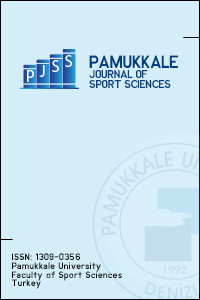Comparison of Cardiopulmonary Resuscitation Skills of Physically Active and Inactive University Students
Comparison of Cardiopulmonary Resuscitation Skills of Physically Active and Inactive University Students
physical education, PE major physical activity, first aid,
___
- American Heart Association [AHA] (2013). Statistical Update. 2012 Out-of-Hospital Cardiac Arrest. Retrieved from http://cpr.heart.org/AHAECC/CPRAndECC/General/UCM_477263_Cardiac-Arrest-Statistics.jsp
- Badaki-Makun, O., Nadel, F., Donoghue, A., McBride, M., Niles, D., Seacrist, T., ... & Nadkarni, V. M. (2013). Chest compression quality over time in pediatric resuscitations. Pediatrics, 131(3), e797-e804.
- Baubin, M., Schirmer, M., Nogler, M., Semenitz, B., Falk, M., Kroesen, G., Hörtnagl, H. ve Gilly, H. (1996). Rescuer's work capacity and duration of cardiopulmonary resuscitation. Resuscitation, 33(2), 135-139.
- Berrones, A. J. (2010). Does physical fitness mediate the physiological and perceptual responses to 10-minutes of chest compression-only CPR? (Unpublished doctoral dissertation). Florida Atlantic University Boca Raton, Florida.
- Bozkuş, T., Türkmen, M., Kul, M., Özkan, A., Öz, Ü., & Cengiz, C. (2013). Determination and relationships of physical activity level and healthy lifestyle behaviors in physical education students. International Journal of Science Culture and Sport (IntJSCS), 1(3), 49-65.
- Bridgewater, F. H., Zeitz, C., Field, J., Inglis, A., & Poulish, K. (2008). The impact of the ILCOR 2005 CPR guidelines on a physical fitness assessment: a comparison of old and new protocols. Resuscitation, 76(3), 405-412.
- Council of Higher Education [CoHE], 2007. Faculty of Education Teacher Education Undergraduate Programs. Retrieved from http://www.yok.gov.tr/documents/10279/30217/E%C4%9E%C4%B0T%C4%B0M+FAK%C3%9CLTES%C4%B0%20%C3%96%C4%9ERETMEN+YET%C4%B0%C5%9ET%C4%B0RME+L%C4%B0SANS+PROGRAMLARI.pdf/054dfc9e-a753-42e6-a8ad-674180d6e382
- Field J. M., Hazinski, M. F., Sayre, M. R., Chameides, L., Schexnayder, S. M., Hemphill, R., ... Vanden Hoek, T. L. (2010). Part 1: Executive summary: 2010 American Heart Association Guidelines for Cardiopulmonary Resuscitation and Emergency Cardiovascular Care. Circulation, 122(suppl 3), S640–S656.
- Hansen, D., Vranckx, P., Broekmans, T., Eijnde, B. O., Beckers, W., Vandekerckhove, P., ... & Dendale, P. (2012). Physical fitness affects the quality of single operator cardiocerebral resuscitation in healthcare professionals. European Journal of Emergency Medicine, 19(1), 28-34.
- Kitamura, T., Iwami, T., Kawamura, T., Nagao, K., Tanaka, H., & Hiraide, A. (2010). Bystander-initiated rescue breathing for out-of-hospital cardiac arrests of noncardiac origin. Circulation, 122(3), 293-299.
- Lucia, A., José, F., Perez, M., Elvira, J. C., Carvajal, A., Álvarez, A. J., & Chicharro, J. L. (1999). The importance of physical fitness in the performance of adequate cardiopulmonary resuscitation. CHEST Journal, 115(1), 158-164.
- Lloyd-Jones, D., Adams, R. J., Brown, T. M., Carnethon, M., Dai, S., De Simone, G., ... & Go, A. (2010). Heart disease and stroke statistics—2010 update. Circulation, 121(7), e46-e215.
- McKenna, S. P., & Glendon, A. L. (1985). Occupational first aid training: Decay in cardiopulmonary resuscitation (CPR) skills. Journal of Occupational Psychology, 58(2), 109-117.
- Nolan, J. P., Soar, J., Zideman, D. A., Biarent, D., Bossaert, L. L., Deakin, C., ... & Böttiger, B. (2010). European resuscitation council guidelines for resuscitation 2010 section 1. Executive summary. Resuscitation, 81(10), 1219-1276.
- Ochoa, F. J., Ramalle-Gomara, E., Lisa, V., & Saralegui, I. (1998). The effect of rescuer fatigue on the quality of chest compressions. Resuscitation, 37(3), 149-152.
- Ock, S. M., Kim, Y. M., hye Chung, J., & Kim, S. H. (2011). Influence of physical fitness on the performance of 5-minute continuous chest compression. European Journal of Emergency Medicine, 18(5), 251-256.
- Petersen, S., Byrne, H., & Cruz, L. (2003). The reality of fitness for pre-service teachers: What physical education majors" know and can do". The Physical Educator, 60(1), 5-18.
- Pierce, E. F., Eastman, N. W., McGowan, R. W., & Legnola, M. L. (1992). Metabolic demands and perceived exertion during cardiopulmonary resuscitation. Perceptual and Motor Skills, 74(1), 323-328. Rajab, T. K., Pozner, C. N., Conrad, C., Cohn, L. H., & Schmitto, J. D. (2011). Technique for chest compressions in adult CPR. World Journal of Emergency Surgery, 6(1), 41.
- Republic of Turkey Prime Ministry Disaster & Emergency Management Authority [AFAD], Earthquake Department (2013). Annual Number of Earthquakes. Retrieved from http://www.deprem.gov.tr/tr/genelistatistikler
- Russo, S. G., Neumann, P., Reinhardt, S., Timmermann, A., Niklas, A., Quintel, M., & Eich, C. B. (2011). Impact of physical fitness and biometric data on the quality of external chest compression: A randomised, crossover trial. BMC Emergency Medicine, 11(1), 20.
- Turkish Statistical Institute [TUIK] (2013a). Causes of Death Statistics. News Bulletin of Turkish Statistical Institute, Number: 16162. Ankara, Turkey.
- Turkish Statistical Institute [TUIK] (2013b). Traffic Accident Statistics, Road. General Directorate of Public Security, Turkish Statistical Institute. Ankara, Turkey.
- Van Hoeyweghen, R. J., Verbruggen, G., Rademakers, F., & Bossaert, L. L. (1991). The physiologic response of CPR training. Annals of Emergency Medicine, 20(3), 279-282.
- Yaprak, Y. & Durgun, B. (2009). BESYO özel yetenek sınavına giren gençlerin, yaptıkları spor dallarına göre antropometrik özelliklerinin karşılaştırılması. Beden Egitimi ve Spor Bilimleri Dergisi, 3(2), 120-130.
- Zenginol, M., Al, B., Genc, S., Deveci, I., Yarbil, P., Yılmaz, D. A., ... & Yıldırım, C. (2011). 3 yearly study results of 112 emergency ambulances in the city of Gaziantep. Eurasian Journal of Emergency Medicine, 10, 27-32.
- Başlangıç: 2010
- Yayıncı: Pamukkale Üniversitesi
Emine KUTLAY, Ercan HASLOFÇA, Tezan BİLDİK, Manuel SİLLERO QUİNTANA
EVALUATION OF GENDER KNOWLEDGE, BEHAVIORS AND ATTITUDES OF PHYSICAL TRAINING AND SPORTS STUDENTS
Nermin GÜRHAN, Azize ATLI ÖZBAŞ, Mehmet KOÇAK
Eda MUŞTU ÖZYAKAN, Leyla SARAÇ
Günay YILDIZER, Deniz ŞİMŞEK, İzzet KIRKAYA, Elvin ONARICI GÜNGÖR
Self-Objectification in the Fitness Center Environment: A Qualitative Perspective
Research of the Coordination Abilities in Rhythmic Gymnastics
